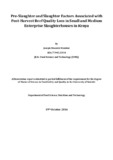| dc.description.abstract | Pre-slaughter and slaughter practices are important for meat quality. Unfortunately, in Kenya, codes of practices for both pre-slaughter and slaughter are missing most notably in the Small and Medium Enterprise (SME) slaughterhouses increasing the risk of low quality meat. The main objective of this study was therefore to assess the pre-slaughter and slaughter factors contributing to post-harvest quality loss of beef in SME slaughterhouses in Kenya. The study was carried in 10 livestock markets located in Kenya’s pastoral areas and Nairobi County and its environs and five SME slaughterhouses in Nairobi County and its environs. The main objective was divided into four specific objectives. The first specific-objective assessed the design of trucks currently used to transport cattle and quantify losses during trucking. Modified floor and smooth interior walls were present in 95.8% and 80.0% of the trucks, while 77.1% and 94.3% of the trucks had side vents and open roofs, respectively. None of the trucks was divided into compartments. Cattle mortality rate during trucking was 6.16% and the major cause was injuries from other animals. In the second specific-objective, the animal welfare knowledge, attitude and practices (KAP) was assessed among 266 stockpeople. Out of a high possible score of 100%, the mean percentage scores of knowledge, attitude, and practice were 78.0 ±14.1%, 75.6 ±16.0% and 64.5 ±17.6%, respectively. The stockpeople scored <70% in knowledge and attitude questions related to animal feeding and watering, and mixing of unfamiliar groups of animals and practices questions related to mixing unfamiliar groups, cooperation with other stakeholders and agitation of animals during handling. In the third specific objective, the level of personal hygienic practices among 207 meat handlers (MH) was assessed. Majority of the MH reported that they do not always use soap and disposable towels during hand washing and gloves during meat handling, clean their equipment between carcasses or keep their equipment
xiii | P a g e
away from their protective clothes when not in use. In the final specific-objective, the level of microbial contamination of carcasses, personnel and equipment was assessed in 225 swab samples collected at various slaughter stages. The contamination of carcasses increased from flaying to dispatch. Contamination of personnel was highest at flaying and evisceration. Contamination of knives was highest at flaying. In conclusion, the pre-slaughter and slaughter factors, which may contribute to post slaughter meat quality loss, are prevalent as evident in the study. Measures, such as training, should be put in place to address them. | en_US |



